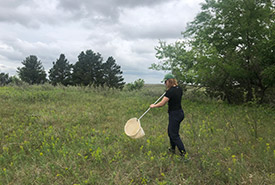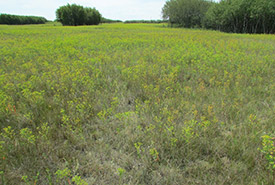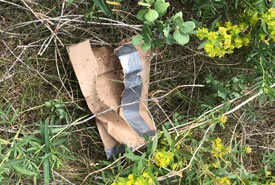Little beetle, big project

Beetle collection (Photo by NCC)
This summer, the Nature Conservancy of Canada (NCC) held a leafy spurge beetle collection event at Willner-Elbow community pasture, where 50,000 leafy spurge beetles were collected in three hours among 12 people. That’s an average of 1,388 beetles per person per hour! The event was led by Matthew Braun, NCC’s working landscapes program director, and Krista Ellingson, NCC’s working landscapes natural area manager. Twelve people volunteered their time to help collect beetles to combat leafy spurge, an invasive species.
The Willner-Elbow pasture, a mix of aspen, sand dunes, shrubs and grasslands, is a complicated landscape. The group managing the land has developed and implemented a weed management plan that combines selective herbicide spraying, biocontrol release, targeted grazing and a monitoring program. Biocontrol includes leafy spurge beetles and 3,500 goats that spend their summer grazing leafy spurge plants under the guidance of a herder. Herbicide spraying is targeted along the outer edges of the largest patches to contain the spurge within a given area and push it back. The monitoring program includes annual visits to specific locations to measure stem density and beetle presence. While monitoring doesn't sound like a big deal, it's very important so that they can make sure what they're doing is actually effective.

Field with leafy spurge (Photo by NCC)
This is the second year using volunteers to spread existing populations of beetles in the community pasture just east of Elbow, Saskatchewan. Leafy spurge beetles, used as biocontrol for the invasive plant, were collected in the pasture and relocated to different sections of the same pasture in hard-to-get-to places where leafy spurge is growing rapidly but where a beetle population isn’t yet present. Leafy spurge can spread faster than the beetles can, as the terrain is very hilly, and it takes the beetles a long time to travel to different patches. That’s why events like this are important.
Agriculture and Agri-food Canada’s Lethbridge, Alberta, research centre helped select the beetle from Europe, test its safety and efficacy here in Canada and released the beetle in 1991. Professional entomologists use a very rigorous screening process to look for the natural pests of imported weeds. They trace the invasive species back to where it is from and look for all the different pests that it hosts there. They then test the different species to see which ones are very specific to the invasive plant to make sure that the pests don't jump to other commercial plants in Canada or native plants here. NCC, like many other agencies and land managers, uses the beetle’s presence here to our advantage and coordinates with the plant health technical advisors officers employed by the Saskatchewan Association of Rural Municipalities by logging the location of beetles collected and where they are released.
It was a very successful collection this year, with three paper lunch bags full of beetles. Volumetric measuring is used to determine the amount collected. There are some different options that work for this — a plastic 35-millimetre film container filled one-quarter of the way full is about 1,000 leafy spurge beetles. Other small containers can also be used, with 10 cubic centimetres, or 10 millilitres, equalling about 1,000 beetles, which means around 50,000 beetles were collected in three hours.
It's best to try and catch the beetles on hot sunny days when they are active in the flowers of the upper third of the plant. The adults go up top to feed and mate, meaning that all the beetles caught are of reproductive age and are able to sustain their population in their new patch of leafy spurge. To catch the beetles when they are in the top canopy, collectors sweep their net horizontally across the patch, with the opening of their net facing forward. All of the plants knock against the rim of the net so that anything that is loose at the top falls into the back of the net. It’s important to use a back-and-forth sweeping motion so that everything stays in the back of the net. As this method catches a lot of debris as well as the beetles, coillectors have to sort what they catch. To do this, everything from the net is put in a large tube with many holes the size of the very small leafy spurge beetles drilled in it. Then it's capped off with the mixture of beetles and plant material inside, placed in a white pillowcase that allows sunlight through and is set in the sun. The beetles escape through the tiny holes, moving toward the light and into the white pillowcase.
Once sorted, the beetles are then transferred into a breathable paper bag, with duct tape around the ends to keep the insects from escaping. They are placed in a cooler and the countdown begins. The chances of a successful release to a new home are best within 48 hours of collection. It is important to keep them cool, release them directly into a patch of leafy spurge, and in a big group as well because they like to be together. It sounds like popcorn popping in a bag because they move around with explosive jumps against the bag.
Sorting the beetles was an ongoing process. People would bring their beetles and vegetation filled nets in and stuff the material into the tube. While that was happening, a different pillowcase of sorted beetles was put into paper bags. It took surprisingly little time for the beetles to sort themselves out, crawling out of the tube and into the pillowcase. It worked remarkably well.

Flea beetles released with leafy spurge (Photo by NCC)
Leafy spurge beetles are one of several successful control measures in place at the rugged Willner-Elbow pasture. Where the aspen and shrub covered sand dunes are too rugged for goats or sprayers, the beetles are doing the job of controlling leafy spurge. With a little help from volunteers, these little insects can more quickly be directed to where they are need most.
We asked Matthew why it’s important to tackle invasive species like leafy spurge. “The Nature Conservancy of Canada not only conserves habitat, but also works to maintain or improve habitat quality," says Matthew. "Invasive species like leafy spurge are aggressive. If left unchecked, they can dominate a site, reducing its biodiversity and its value to livestock producers.
“The Wilner-Elbow pasture is beautiful and it's a real privilege to be invited there to work with the pasture group and, in turn, to invite our network of volunteers from around Saskatchewan to help manage a unique landscape that many people don’t even know exists in Saskatchewan. I love the opportunity to tell the story of why these pastures are important and how they provide for our communities, not just the food and the economy, but environmental services that benefit us all.”



